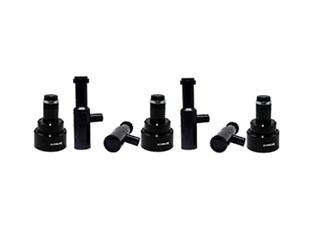Telecentric field lenses and telecentric lenses are related in function and design, but are not exactly the same concept.


Definitions and uses:
Telecentric Field Mirror (also known as Telecentric Scanning Lens or Telecentric F-THETA Mirror): It is a specially designed scanning lens used to ensure that the main light rays of the focused beam are perpendicular to the focal plane at any field of view. The telecentric field mirror plays a key role in the scanning system, controlling the angle of incidence of the laser through the deflection of the motor inside the galvanometer, so that the laser is focused on the same machining plane, realizing one-dimensional or two-dimensional linear movement. This type of lens has a wide range of uses in laser welding, marking/engraving, drilling and other applications.
Telecentric lens (Telecentric lens): mainly designed to correct the parallax of traditional industrial lenses, which can keep the image magnification constant within a certain object distance. Telecentric lens is divided into object-square telecentric lens, image-square telecentric lens and both sides of the telecentric lens, of which the object-square telecentric lens is commonly used in industrial precision measurements, because of its very small aberration, and can even achieve no aberration.
Functional Features:
Telecentric Field Mirror: A special design ensures that the main rays of the focused beam are perpendicular to the focal plane at all field of view angles, resulting in consistent machining results across the entire machining surface. In addition, telecentric field mirrors eliminate the problem of lateral beam movement due to objects deviating from the focal plane.
Telecentric lens: Its main feature is that it can keep the image magnification unchanged within a certain object distance, which is especially important for the case where the measured object is not on the same object plane. Telecentric lenses can receive the main rays parallel to the optical axis, thus avoiding the measurement errors caused by parallax in conventional lenses.
Links and Differences:
Related: Telecentric field mirrors and telecentric lenses are both designed to solve the problems of traditional lenses, and they both improve imaging quality and measurement accuracy to a certain extent.
Difference: Telecentric field lenses are more focused on achieving precise laser control and consistent processing results in scanning systems; while telecentric lenses are more focused on correcting parallax and keeping image magnification constant in machine vision systems.
While telecentric field mirrors and telecentric lenses are somewhat related, they differ in their definitions, uses and functional characteristics. Telecentric field mirrors are primarily used for laser processing applications in scanning systems, while telecentric lenses are more focused on imaging and measurement applications in machine vision systems.
Product recommendation
TECHNICAL SOLUTION
MORE+You may also be interested in the following information
FREE CONSULTING SERVICE
Let’s help you to find the right solution for your project!


 ASK POMEAS
ASK POMEAS  PRICE INQUIRY
PRICE INQUIRY  REQUEST DEMO/TEST
REQUEST DEMO/TEST  FREE TRIAL UNIT
FREE TRIAL UNIT  ACCURATE SELECTION
ACCURATE SELECTION  ADDRESS
ADDRESS Tel:+ 86-0769-2266 0867
Tel:+ 86-0769-2266 0867 Fax:+ 86-0769-2266 0867
Fax:+ 86-0769-2266 0867 E-mail:marketing@pomeas.com
E-mail:marketing@pomeas.com
